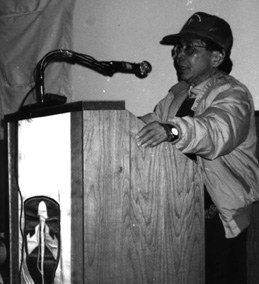 |
The 1898-1998 Philippine Centennial CommemorationBy Dong TizonThe Philippines were a colony of the Spanish Empire for three hundred years, beginning in 1521. By the late 1800s, this empire was on the brink of collapse because of problems at home and due to peoples in Latin and Central America declaring their independence from Spain. In 1895, Spain was having problems suppressing the Cuban uprising; by 1896, organized Filipinos in Manila were in open rebellion. This would eventually become a nationwide movement. The United States, a new expanding power, eventually clashed with Spain in the Spanish-American War. In May 1898, US Commodore George Dewey steamed into Manila Bay to attack the Spanish fleet, but by this time the Spanish army in the Philippines was all but thoroughly beaten. The Spaniards controlled only the old walled city of Manila, and the Filipinos were dug in around the city perimeter preparing to finish them off. Spain was prepared to surrender, but not to the Filipinos. A surrender to the Americans was negotiated - on condition that a mock battle be held first. In August 1898, a "battle" took place in Manila Bay between the remnants of the Spanish army and the Americans, during which the Americans prevented the Filipinos from entering the city. The Spaniards then surrendered to Dewey and the Americans took possession of Manila. On December 10, 1898, Spain ceded the Philippines to the United States in the Treaty of Paris. Ratification of this treaty required a two-thirds majority in the US Senate. Despite a strong anti-imperialist movement in the country and an anti-annexationist group in the Senate, the treaty was ratified in the context of the Philippine-American War which broke out in February of 1899. Some historians claim that the war (known as the Philippine Insurrection in the States) was initiated to influence the approval of the treaty. It is little-known in American historical accounts and rarely taught in American schools.
It was a brutal and racist war. The statement of General Shafter in April 1899 is characteristic: "It may be necessary to kill half the Filipinos in order that the remaining half of the population may be advanced to a higher plane of life than their present semi-barbarous state affords." The war eventually became a war against the population itself, which refused to be pacified. The Balangiga Massacre, which took place on the island of Samar, serves as a famous example. American troops placed the population of the town in a concentration camp, forcing them to sleep standing up in wooden pens at night. Guerrillas infiltrated the town. On the early morning of September 1901, at the signal of a pealing church bell, they attacked the American garrison as it was having breakfast. Fifty-four Americans died due to wounds inflicted by bolo knives, and eighteen escaped with serious injuries. In response, General Jack Smith was asked to lead a campaign of extermination that was unprecedented until then. His order was: "Kill and burn, kill and burn, the more you kill and the more you burn the more you please me." He ordered the killing of all males over ten years of age. He vowed to turn Samar into a "howling wilderness." It is difficult to determine the number of Filipinos who died as a result of the war from bullets, disease, and starvation. Records were not kept. General Bell gave an estimate in a May 1901 New York Times interview; he calculated over 600,000 deaths in Luzon alone. This estimation excludes figures from other places such as Samar and Mindanao and of course does not take into account the war after 1901. Some historians have brought up the similarities between the Vietnam War and the Philippine-American War. There are similarities but there are also many differences. For instance, the Vietnamese people won, and in the United States during the Vietnam War there was a civil rights movement and an antiwar movement, while during the Philippine-American War, an intense nationalism and jingoism ruled public sentiment. Much war booty was brought back to the United States, some of which can be found in museums and libraries and in private collections. Somewhere in Wisconsin, the bell from the church tower of Balangiga, Samar is lying in some museum or town square as a silent reminder of a forgotten war. Sources for this article: Luzviminda Francisco, "The First Vietnam, The Philippine-American War 1899-1902," Bulletin of Concerned Asian Scholars (Dec. 1973, 2-16); Stuart Creighton Miller, Benevolent Assimilation (1982, New Haven: Yale University Press) Dong Tizon is a Philippine activist who was imprisoned under the Marcos regime. He currently does social work in Chicago.
|


 The Filipino army suffered heavy losses in a war of position against a better-trained and better-armed enemy - one that had developed military techniques during the Civil War and the wars against the American Indians. US military officials predicted that the war would end in a few months. But when Filipinos shifted to guerrilla tactics the war dragged on, even after General Aguinaldo's capture in April 1901. The last significant armed opposition lasted until 1916, but throughout the American colonization period opposition persisted, especially in mountainous and rural areas of the Philippines.
The Filipino army suffered heavy losses in a war of position against a better-trained and better-armed enemy - one that had developed military techniques during the Civil War and the wars against the American Indians. US military officials predicted that the war would end in a few months. But when Filipinos shifted to guerrilla tactics the war dragged on, even after General Aguinaldo's capture in April 1901. The last significant armed opposition lasted until 1916, but throughout the American colonization period opposition persisted, especially in mountainous and rural areas of the Philippines.